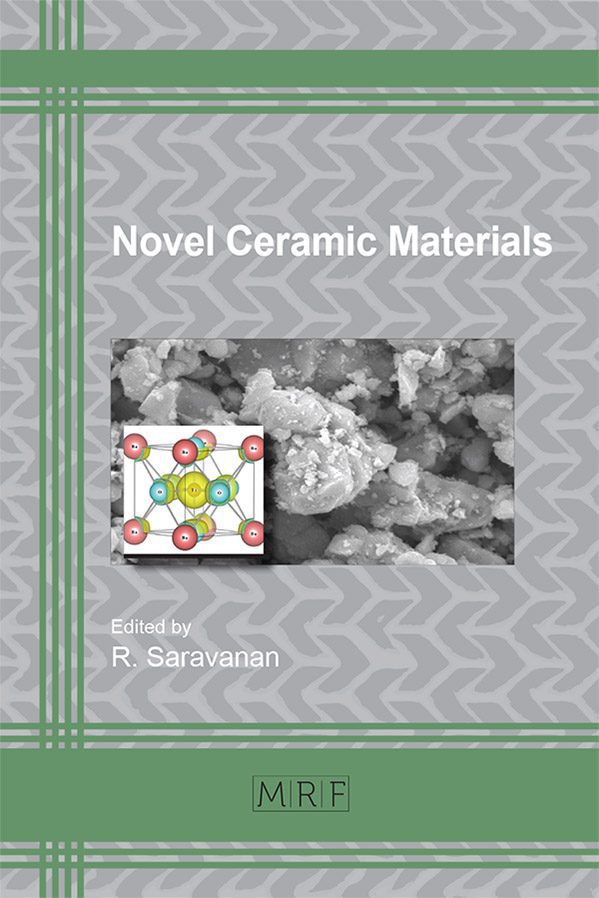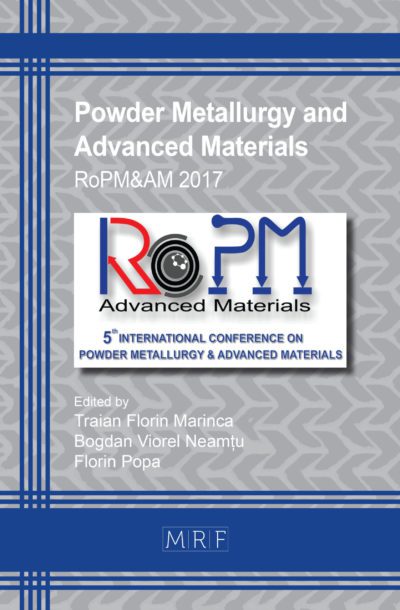Synthesis, Characterization and Charge Density Analysis of Lead Free Piezoceramics Na1-xKxNbO3
S. Sasikumar, R. Saravanan
Solid solutions of lead free ceramics of Na1-xKxNbO3 (x=0.01, 0.03 and 0.05) were prepared by the conventional solid state reaction method. The formation of perovskite structure of the prepared ceramics was confirmed by means of room temperature powder X-ray diffraction. The powder X-ray diffraction study confirmed that Na1-xKxNbO3 (x=0.01, 0.03 and 0.05) adopted the orthorhombic structure. The crystal structures were refined using profile refinement. The electron density distributions of these crystals were analysed with the maximum entropy method (MEM) using powder X-ray diffraction data. Aggregated average particle sizes were evaluated using scanning electron microscopy. Elemental compositional analysis was carried out using energy dispersive spectrum. Optical properties are analyzed by UV-Visible spectrum.
Keywords
Crystal Structure, X-Ray Diffraction, Rietveld Analysis, Optical Properties, Polyhedral
Published online 6/1/2016, 13 pages
DOI: 10.21741/9781945291036-2
Part of Novel Ceramic Materials
References
[1] Y. Saito, H. Takao, T. Tani, T. Nonoyama, K. Takatori, T. Homma, et.al. Lead-free piezoceramics, Nature 432 (2004) 84–7.
http://dx.doi.org/10.1038/nature03028
[2] E.K. Akdogan, K. Kerman, M. Abazari, A. Safari, Origin of high piezoelectric activity in ferroelectric (K0.44Na0.52Li0.04)–(Nb0.84Ta0.1Sb0.06)O3 ceramics, Appl. Phys. Lett. (2008) 92.
[3] K. Wang, F.-Z. Yao, W. Jo, D. Gobeljic, V.V. Shvartsman, D.C. Lupascu, etal. Temperature-insensitive (K, Na)NbO3-based lead-free piezo actuator ceramics, Adv. Funct. Mater. 23 (2013) 4 079–86.
[4] M.-S. Kim, S. Jeon, D.-S. Lee, S.-J. Jeong, J.-S. Song, Lead-free NKN-5LT piezoelectric materials for multilayer ceramic actuator, J. Electro. Ceram. 23 (2009) 372–5.
http://dx.doi.org/10.1007/s10832-008-9470-x
[5] S. Kawada, M. Kimura, Y. Higuchi, H. Takagi, (K,Na)NbO3-based multilayer piezoelectric ceramics with nickel inner electrodes. Appl. Phys. Express. (2009) 2.
http://dx.doi.org/10.1143/apex.2.111401
[6] J. Jin, D. Wan, Y. Yang, Q. Li, M. Zha, A linear ultrasonic motor using (K0.5Na0.5) NbO3 based lead-free piezo electric ceramics. Sens. Actuator A: Phys. 165 (2011) 410–4.
http://dx.doi.org/10.1016/j.sna.2010.10.017
[7] S. In-Tae, K. In-Young, C. You-Jeong, C. Jae-Hong, N. Sahn, S. Tae-H yun, et al. Piezoelectric properties of CuO-added (Na0.5K0.5)NbO3 ceramic multilayers. J. Eur. Ceram. Soc. 32 (2012) 1085–90.
http://dx.doi.org/10.1016/j.jeurceramsoc.2011.11.020
[8] K. Motoo, F. Arai, T. Fukuda, M. Matsubara, K. Kikuta, T. Yamaguchi, et al. Touch sensor for micro manipulation with pipette using lead-free (K, Na)(Nb, Ta)O3 piezoelectric ceramics. J. Appl. Phys. (2005) 98.
[9] M. Guo, K.H. Lam, D.M. Lin, S. Wang, K.W. Kwok, H.L.W. Chan, et al. A Rosen-type piezoelectric transformer employing lead-free K0.5Na0.5NbO3 ceramics, J. Mater. Sci. 43 (2008) 709–14.
http://dx.doi.org/10.1007/s10853-007-2199-0
[10] E. Cross, Materials Science-lead-free at last, Nature 432 (2004) 24–5.
http://dx.doi.org/10.1038/nature03142
[11] G. Shirane, R. Newnham, R. Pepinsky, Dielectric properties and phase transitions of NaNbO3 and (Na, K)NbO3, Physical Review 96 (1954) 581–588.
http://dx.doi.org/10.1103/PhysRev.96.581
[12] R.E. Jaeger, L. Egerton, Hot pressing of potassium-sodium niobates, Journal of the American Ceramic Society, 45 (1962) 209-213.
http://dx.doi.org/10.1111/j.1151-2916.1962.tb11127.x
[13] Y. Saito, H. Takao, T. Tani, T. Nonoyama, K. Takatori, T. Homma, T. Nagaya, M. Nakamura, Lead-free piezoceramics, Nature 432 (2004) 84-87.
http://dx.doi.org/10.1038/nature03028
[14] L. Egerton, D.M. Dillom, Piezoelectric and Dielectric Properties of Ceramics in the System Potassium-Sodium Niobate, J. Am. Ceram. Soc. 42 (1959) 438.
http://dx.doi.org/10.1111/j.1151-2916.1959.tb12971.x
[15] H.M. Rietveld, A Profile Refinement Method for Nuclear and Magnetic, J. Appl. Crystallogr. 2 (1969) 65.
http://dx.doi.org/10.1107/S0021889869006558
[16] D.M. Collins DM (1982) Electron density images from imperfect data by iterative entropy maximization, Nature 49 298.
[17] V. Petricek, M. Dusek and L. Palatinus, (2006) Jana, The crystallographic computing system (Institute of Physics), Praha, Czech Republic.
[18] R. D. Shannon, Revised effective ionic radii and systematic studies of interatomic distances in halides and chalcogenides. Acta Cryst. A32 (1976) 751-767.
http://dx.doi.org/10.1107/S0567739476001551
[19] K. Momma and F. Izumi, Commission on Crystallogr. Comput., IUCr Newslett 7 (2006) 106.
[20] F. Izumi, R.A. Dilanian, IUCr Newslett 32 (2005) 59.
[21] J.I. Pancove, (1971). Optical processes in semiconductors. Englewood Cliffs, NJ, USA: Prentice Hall.
































